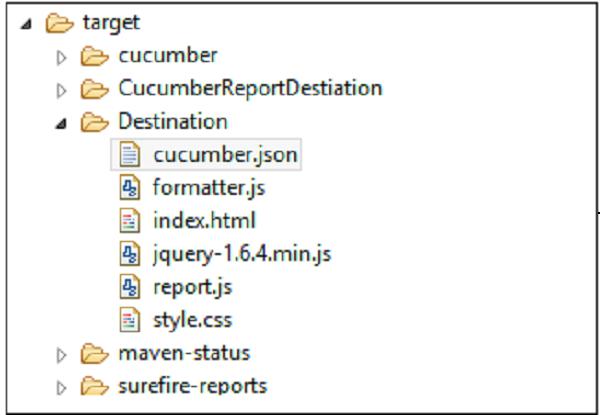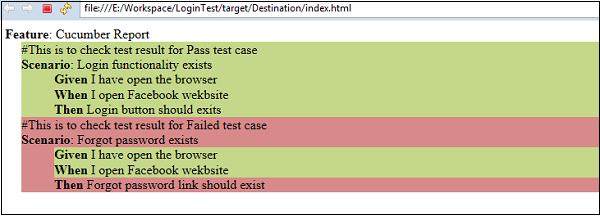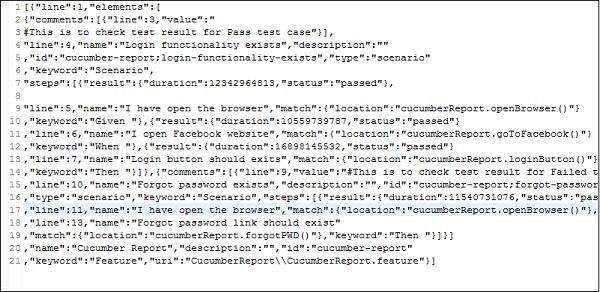Cucumber - Reports
We do test execution in order to understand the stability of a product, so be it manual test or an automated test, it is very important to generate a concise report that can depict the stability of a product. Hence, while we are automating our test scenario with Cucumber, it is essential to know, how better we can generate our Cucumber test reports. As we know that Cucumber is a BDD framework, it does not have a fancy reporting mechanism.
In order to achieve this, we need to integrate Cucumber with other open source tool like Ant/Junit. Here, we will take examples of JUnit further because, it provides support for Java language.
Let’s look into the details of different report format, which is available and easy to use −
Pretty Format (HTML Report)
Pretty Format generates the Cucumber test report in the HTML format, i.e. an HTML file. It is the most readable report format. It generates the report in the same way as it is a feature file, so tracing is also made easy. Also, you can specify the location where you want this report to be placed after the test execution. It can be −
Local Directory − We can specify target directory for report as any local directory of the machine where the test will run.
Server Directory − Also we have a provision to specify a target directory as any directory on the server, which is publically accessible. This generally helps when we want our clients/stakeholders to view the test results at any given point of time.
Example
Let’s automate an example of a pretty format.
Step 1 − Create a Maven project named cucumberReport in Eclipse.
Step 2 − Create a package named CucumberReport under src/test/java
Step 3 − Create a feature file named cucumberReport.feature
Write the following text within the file and save it.
Feature − Cucumber Report
#This is to check test result for Pass test case
Scenario: Login functionality exists
Given I have opened the browser
When I open Facebook website
Then Login button should exist
#This is to check test result for Failed test case
Scenario: Forgot password exists
Given I have open the browser
When I open Facebook website
Then Forgot password link should exist
Note − Here scenario first will pass, whereas the second scenario will fail. So that we can witness how the pass and failed report looks like.
Step 4 − Create a step definition file.
Select and right-click on the package outline.
Click on ‘New’ file.
Give the file name as cucumberReport.java
Write the following text within the file and save it.
package CucumberReport;
import org.openqa.selenium.By;
import org.openqa.selenium.WebDriver;
import org.openqa.selenium.firefox.FirefoxDriver;
import cucumber.annotation.en.Given;
import cucumber.annotation.en.Then;
import cucumber.annotation.en.When;
public class cucumberReport {
WebDriver driver = null;
@Given("^I have open the browser$")
public void openBrowser() {
driver = new FirefoxDriver();
}
@When("^I open Facebook website$")
public void goToFacebook() {
driver.navigate().to("https://www.facebook.com/");
}
@Then("^Login button should exits$")
public void loginButton() {
if(driver.findElement(By.id("u_0_v")).isEnabled()) {
System.out.println("Test 1 Pass");
} else {
System.out.println("Test 1 Fail");
}
}
@Then("^Forgot password link should exist$")
public void forgotPWD() {
if(driver.findElement(By.id("")).isEnabled()) {
System.out.println("Test 1 Pass");
} else {
System.out.println("Test 1 Fail");
}
}
}
Step 5 − Create a runner class file.
package CucumberReport;
import org.junit.runner.RunWith;
import cucumber.junit.Cucumber;
@RunWith(Cucumber.class)
@Cucumber.Options(
format = {"pretty", "html:target/Destination"} )
//Specifying pretty as a format option ensure that HTML report will be generated.
//When we specify html:target/Destination - It will generate the HTML report
inside the Destination folder, in the target folder of the maven project.
public class runTest { }
You will observe the following things when you run this class file.
Both the scenario will get executed one by one.
A folder named Destination will be created inside the target directory.

The report will be there named as “Index.html”.
Open Index.html with web browser.
You will see the report mentioned in the following image −

It exactly highlights the color of failed scenario. Moreover, you will see highlight for failed step in that scenario. This makes the debugging very easy.
JSON Report
By now we have seen how easy HTML report is. However, if we want to pass on this report information to any other application, that’s kind of tricky in case of HTML reports. Here comes the need of another reporting format. JSON-Java script object notation is another format for generating Cucumber test reports. JSON is an object containing a lot of information stored in text format. JSON reports bring a different value to the table. JSON report can also be used as a payload of information to be transferred between different servers. Further, it can be used to be displayed as a web page. In a nutshell, JSON reports can be used by other application.
What is payload information? When data is sent over the Internet, each unit transmitted includes both header information and the actual data being sent. The header identifies the source and destination of the packet, while the actual data is referred to as the payload. In order to generate a JSON report, we just need to make a change in the runner file.
package CucumberReport;
import org.junit.runner.RunWith;
import cucumber.junit.Cucumber;
@RunWith(Cucumber.class)
@Cucumber.Options( format={"json:target/Destination/cucumber.json"})
//When we specify json:target/Destination/cucumber.json - It will generate the JSON
report inside the Destination folder, in the target folder of the maven project.
public class runTest {}

The report will be there named as cucumber.json (as provided in runner class).
Open cucumber.json file with the text editor.
You will see the report mentioned in the following screenshot after placing line breaks −

Note − JSON is less readable as compared to the HTML report format.






